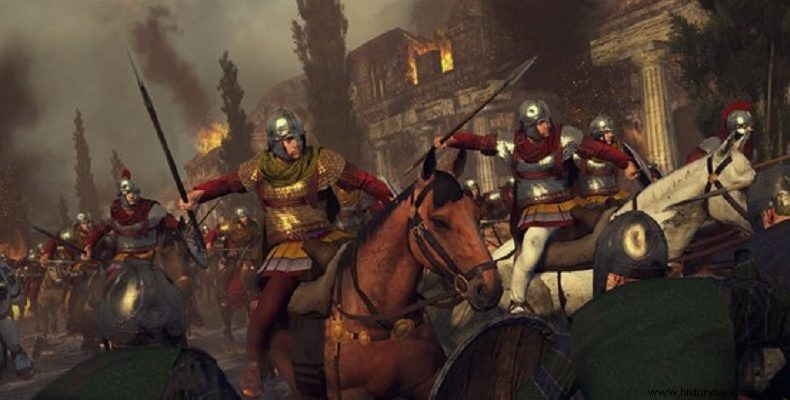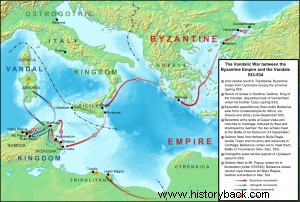
In 533 AD Justinian assigned the general Belisarius to conquer the marauding state of the Germanic Vandals in North Africa. For this purpose he allocated only 5,000 cavalry and 10,000 infantry. Of the horsemen, 1,000 were Huns and Germans, 1,500 elite buccalarians, under John Troglitis, and the rest of the cavalry under his childhood friend Rufinus.
The infantry consisted of heavily armed scutatus (satellites) and small archers, archers, slingers and javelinmen. John of Dyrrachium was appointed the leader of the infantry . With these forces Belisarius would have to fight, in a plain country, against the best horsemen in the world, as the Vandals were considered.
The "future dead"
Belisarius, after completing the preparations, set sail in March 533 AD. from Constantinople, in a climate of concern, as he and the men were considered almost certain to die . Indicative of the prevailing climate was the discussion between the prefect of Constantinople and Justinian's close associate John Cappadocis.
"I fear that this disaster will prove to be as great as that which our ancestors suffered from Jericho" , said the prefect referring to the crushing defeat of the Byzantines by the Vandals under Emperor Leo A.
“This cannot happen. In that campaign we lost 100,000 men, but now I have persuaded the emperor to send only 15,000, most of them footmen' , replied Cappadocis.
"And what combat power do you expect the Vandals to have" , the prefect asked again.
"More than 100,000 men, if you count their Moorish subjects" , replied Cappadocis indifferently.
"Then what hopes of success can Belisarius have?", asked the surprised prefect.
Cappadocia casually shrugged his shoulders and replied, "Every despot can dream."
Descent and route to Dekimos
On June 24, 533 AD the small Byzantine army landed in North Africa. The Vandal king Gelimeros was not in his capital at that time. He had left his brother Amata as a watchman on the throne who informed him about the landing of the Byzantines. Gelimeros then hastened to Carthage, ordering his brother to hasten with all available forces to seize the strait at the tenth mile signpost (Tenth) from the capital of Carthage , no later than the morning of July 3rd.
Gelimeros planned in this position to destroy the Byzantine Army. Amatas would hold the strait and he himself, with the bulk of the army, would move south of it and surround and slaughter Belisarius' army.
In the meantime, Belisarius, ignoring the movements of his opponent, advanced his army towards Carthage, covering his left flank with his 600 Hunnic horsemen. He also ordered Ioannis Troglitis to move with 300 buccaneers, as an advance guard, at a distance of 4 km. from the main body.
On July 3, the small Byzantine army arrived at a distance of about 8 km from the strait of Decimos. Belisarius did not think of immediately extorting the passage. He ordered his men to build a new fortified camp, so that even if the slightest accident occurred, they would have a shelter.
Amatas, on the other hand, had been dramatically delayed in understanding and manning the strait of the Tenth with serious forces. At noon on the 3rd of July, only he and 100 horsemen were there, but again without having even taken up battle positions. Amatas had ordered the Carthaginian Vandals to follow him. But his Vandal soldiers were slow to "recruit".
So Gelimeros changed his plan and decided to move himself with about 30,000 men (newer historians speak of only 9,000 men) towards the Decimus and join his brother's forces. At the same time, he commissioned his nephew Givamundos, with 2,000 horsemen, to perform a super-canonical maneuver, encircling the Byzantines, while he himself would attack them head-on.
The 300 buccalarians and the Huns
Belisarius, having ensured his defense, outside the narrow passage, ordered his friend John with the 300 buccalarians to move inside. Since he hadn't spotted any serious Vandal forces occupying it by then, he figured he'd be the first to capture it. Indeed John's men moved cautiously within the narrowness. Suddenly they spotted the 100 Vandals of Amata and attacked them.
The Vandals fought bravely killing 12 Byzantines. But in the end they were defeated and disbanded. And Amatas, who tried to attack John, received from the Byzantine officer a hand cannon (or riptario, a type of arrow-shaped projectile thrown by hand) and fell dead. After this the surviving Vandals fled in panic, pursued on foot by the buccalarians.
The fugitive Vandals, in their panic, also put to flight their fellow soldiers, who were coming unorganized in small groups from Carthage to man the defensive line at the strait. Thus in the entire distance of 14 km from the strait of Decimos, to the walls of Carthage, thousands of Vandals ran in panic to escape the advance of 288 Byzantine buccalarians!
Panicked, the Vandals fled to Carthage, where they were "besieged" by the three centarchies (islands) of the Bucellarians! The success of Ioannis Troglitis gained even more weight since it precluded any reinforcement mission to the army of Gelimeros.
Belisarius took advantage of the fact that the strait was open and ordered the rest of the cavalry to move into it, except for his 600 Hunnic horsemen. The Huns moving to the left of the strait spotted the 2,000 Vandals of Givamundos.
Then approaching within bowshot distance they began to reap the Vandals with arrows. When the latter charged against them, the Huns retreated, only to come back again shortly, always in an acrobolism arrangement. The Vandals were particularly strained by this "stealth war" and when they received the advance of the Huns they could not stand it and dispersed. The Huns pursued them and slaughtered them all.
Gelimeros crashes
Already the plan of Gelimeros had collapsed. The only intact part of the army was the one he commanded, which was however twice the size of the Byzantine Army as a whole. Without knowing what had happened, Gelimeros also moved towards the narrowness of the Tenth.
At the same time a centarchy of cavalry and the Germans of Belisarius, 500 horsemen in all, arrived at the western exit of the strait. Belisarius with another 3,600 horsemen followed. Suddenly the 500 horsemen alerted Belisarius that countless Vandal horsemen were coming from the west. The 100 horsemen, armed with bows as they were, charged and engaged the Vandals. However, the numerical superiority of the enemies forced them to retreat.
In the meantime Gelimeros and his men were informed of the death of his nephew and his brother. This news caused confusion among the Vandals. Belisarius took advantage of this very confusion and decided to counterattack. He divided his horsemen into two bodies and attacked.
The Vandals, who did not expect an attack, were taken by surprise and fell into complete disarray, constantly receiving arrows from the cavalry. Hundreds of Vandals fell from this first "slaughter". Before they fully recovered, they received a second and a third. When they tried to counterattack the horsemen opened their yokes and retreated, avoiding the advance of the enemies.
As soon as the Vandals stopped, the Byzantines returned and launched a new rain of arrows against them. The battle lasted until dusk, when the Vandals, unable to bear the strain and losses any longer, fled, leaving many dead on the battlefield.
Unfortunately for them, several of them fell upon the Huns, who had rushed towards the western entrance of the strait, and were mercilessly slaughtered. Belisarius with 5,000 cavalry, without even engaging his infantry, had crushed 40,000 Vandals , simultaneously cutting them off from their capital Carthage.

